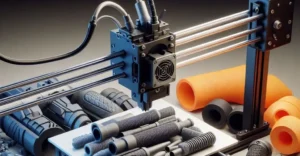Introduction
3D-printed RC cars are a growing trend among hobbyists. They offer a unique opportunity to customize and build your own RC car using 3D printing technology. This guide will walk you through the entire process, from designing and printing parts to assembling and tuning your car for optimal performance.
What is a 3D Printed RC Car?
A 3D-printed RC car is a remote-controlled car where most or all of its components are created using a 3D printer. Unlike traditional RC cars, which rely on pre-manufactured parts, 3D-printed RC cars allow for a high degree of customization and innovation. These cars can be tailored to specific preferences and needs, making them a favorite among DIY enthusiasts.
Benefits of 3D Printing RC Cars
3D printing RC cars come with several benefits:
- Customization: Create unique designs tailored to your preferences.
- Cost-Effectiveness: Print parts at a fraction of the cost of buying pre-made components.
- Rapid Prototyping: Quickly iterate and improve designs.
- Material Experimentation: Use different materials to achieve desired properties.
Getting Started with 3D-Printed RC Cars
Choosing the Right 3D Printer
Selecting the right 3D printer is crucial. Key features to consider include print volume, resolution, and material compatibility. Popular choices include the Prusa i3 MK3S, Creality Ender 3, and Anycubic i3 Mega.
Essential Materials and Tools
To build a 3D-printed RC car, you’ll need:
- Materials: PLA, PETG, TPU, and possibly more specialized filaments.
- Tools: Screwdrivers, cutters, sandpaper, and assembly tools.
Designing Your 3D Printed RC Car
Finding and Customizing Designs
You can find RC car designs on platforms like Thingiverse and MyMiniFactory. These designs can be customized using CAD software to fit your specific needs.
Popular Design Software
Popular software for designing 3D-printed RC car parts includes Tinkercad, Fusion 360, and Blender. These tools offer varying levels of complexity and features to cater to different skill levels.
Mechanical and Electrical Elements in RC Car Design
Mechanical Components
Key mechanical components include the chassis, suspension, tires, and gears. PLA is often used for the chassis, PETG for more durable parts, and TPU for flexible components like tires.
Electrical Components
Essential electrical components include:
- Motor: Powers the car.
- Speed Controller: Regulates the motor speed.
- Battery: Provides power.
- Receiver and Transmitter: Allows for remote control.
- Servo: Controls steering.
Experimenting with Different Materials
Commonly Used Filaments
PLA and PETG are commonly used due to their ease of printing and durability. PLA is ideal for structural parts, while PETG offers more flexibility and strength.
Specialized Materials
TPU is used for tires and suspension due to its flexibility. Continuous fibers can be used to reinforce parts and improve strength.
Printing Your RC Car Parts
Optimizing Print Settings
To achieve high-quality prints, optimize settings like layer height, infill, and support. Ensure good bed adhesion and proper cooling.
Best Practices for High-Quality Prints
- Bed Adhesion: Use a heated bed and appropriate adhesives.
- Cooling Settings: Proper cooling helps achieve fine details.
- Post-Processing: Sanding and smoothing improve the final look and fit.
Assembling Your 3D Printed RC Car
Step-by-Step Assembly Guide
- Prepare Parts: Clean and smooth printed parts.
- Assemble Chassis: Use screws and nuts to attach parts.
- Install Electronics: Secure the motor, speed controller, and battery.
- Final Assembly: Attach wheels, suspension, and other components.
Tools and Screws Needed
You’ll need:
- Screws: M3 and M2.5 screws, nylon locking nuts.
- Tools: Screwdrivers, cutters, pliers.
Painting and Finishing Your 3D Printed RC Car
Surface Preparation
Clean and sand the parts to remove any imperfections. Apply a primer to create a smooth surface.
Painting Techniques
- Spray Painting: Ideal for large surfaces.
- Hand Painting: Great for details and small parts.
- Techniques: Use multiple thin coats, and allow drying between coats.
Testing and Tuning Your RC Car
Initial Test Runs
Conduct initial test runs to ensure all components work correctly. Check for any issues with assembly or electronics.
Tuning for Performance
Adjust the suspension, motor settings, and weight distribution to improve performance. Fine-tune the car to achieve the best balance between speed and control.
Common Issues and Troubleshooting
Identify and solve common issues such as:
- Print Defects: Warping, stringing, and layer shifting.
- Assembly Problems: Misalignment, loose screws.
- Electrical Issues: Poor connections, and malfunctioning components.
Advanced Modifications and Upgrades
Explore advanced modifications like:
- Improving Speed: Upgrading the motor and battery.
- Enhancing Handling: Adjusting suspension and adding weight.
- Durability Upgrades: Using stronger materials and reinforcing parts.
Community and Resources
Online Forums and Groups
Join online communities to share tips, ask questions, and showcase your projects. Popular forums include Reddit’s r/3Dprinting and RC car-specific groups.
Useful Websites and Tools
- Thingiverse: For finding designs.
- Fusion 360: For design software.
- HobbyKing: For purchasing electronic components.
Conclusion
Building a 3D-printed RC car is an exciting and rewarding project. It allows for extensive customization and innovation. With the right materials, tools, and knowledge, you can create a high-performance RC car that stands out from the rest.
FAQs
What materials are best for 3D printing RC car parts?
PLA is great for structural parts, PETG for durability, and TPU for flexible components like tires.
How do I start designing my own RC car parts?
Use CAD software like Fusion 360 or Tinkercad to create and customize designs.
What are common issues when building a 3D-printed RC car?
Common issues include print defects, assembly problems, and electrical malfunctions.
How can I improve the performance of my 3D-printed RC car?
Tune the suspension, upgrade the motor and battery, and adjust weight distribution for better performance.


